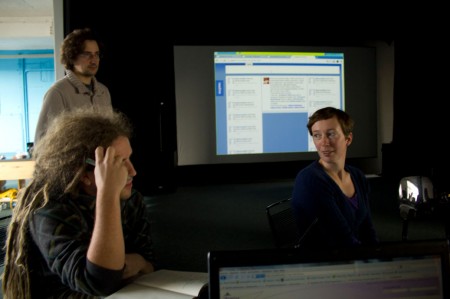The residency we did in september at NIMk was almost exclusively using paper and pens as we were working together to design our game world. We could go for walks while thinking, and mostly keep to analogue methods.
This residency was very different – naturally at this stage focused on the software, we started with an initial list of showstopping things to fix, and then used online methods of organisation via mantis and the wiki.
We also presented the project for the first time, at NIMk’s space invaders event, and we had some super volunteers from Eindhoven Technical University Game Experience Lab to test the game (which Aymeric describes in more detail).
One of the things that I was pleased to get a chance to tackle was how to cope with the basics of online multiplayer games:
- How do we cope with having too many players?
- What do we do with players who haven’t played for a long time?
- How does this shared world repair itself so new players don’t find a world trashed by the earlier players?
The most worrying problem for me was the (perhaps rather hopeful) issue of being swamped by lots of people. This is an interface and resources problem, there has to be a fixed limit somewhere, a point where we have to turn people away. How do we do that?
There are two limits in this game:
A = The number of people playing at one time (interface, game world, and perhaps to a lesser extent CPU limited).
B = The number of people playing in total, with characters and associated data stored in the game (server memory limited).
B is a much higher number than A, so we can hide inactive players in order to accommodate a far higher number of people playing in total than we do simultaneously.
In other cases we are making solutions part of the game itself. For example, “cleaner” bots wander the world removing players who haven’t moved for a week – and at the same time remove items that are left over as a side effect of people playing the game.
Players can move bots around the world along with anything else, so they are given the ability to navigate their way home automatically. In some cases this results in some amusing emergent behaviour.
If left for long enough, the game will clean up all the players and return it to it’s starting point. If lots of people are playing and messing up the game too much, we just create more cleaners! At least, that’s the theory.
Thanks to Maarten Witteveen @ BALTAN for the photography.
Tags: baltan, bots, multiplayer, playtest, residency

